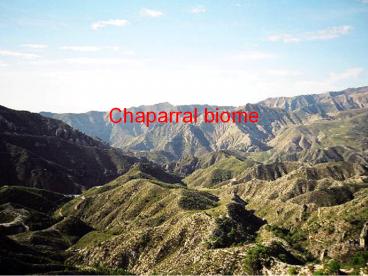Chaparral biome - PowerPoint PPT Presentation
Title:
Chaparral biome
Description:
Chaparral biome Chaparral biomes Chaparrals are Mediterranean climates which are moderately temperate biomes with hot to dry summers and mild to rainy winters. – PowerPoint PPT presentation
Number of Views:130
Avg rating:3.0/5.0
Title: Chaparral biome
1
Chaparral biome
2
Chaparral biomes
- Chaparrals are Mediterranean climates which are
moderately temperate biomes with hot to dry
summers and mild to rainy winters. These biomes
are often referred to as a woodland biome or a
Mediterranean biome.
3
Plants of the Chaparral
- consist of mostly forests, woodlands and shrubs
with vegetation types that can range from forests
to woodlands to savannas to shrublands and to
grasslands - Hardwood evergreen trees such as oak are very
popular in chaparral biomes such as blue oak,
poison oak, cork oak, scrub oak, and live oak. - consist of around 48,250 known vascular plan
species which is almost 20 of the total plants
known world wide.
4
Plants and shrubs
- Plants that have adapted to this biome are
typically less than a meter tall and are very
shrubby in appearance. They have many
characteristics of desert plants due to the hot
dry climate and many are annuals that only flower
briefly after rains. These plants are adapted to
this environment because of the lower rain fall
periodically throughout the year and the fact
that hardwoods do not drastically need water all
the time.
5
Animals of the Chaparral
- The animals in the chaparral biome highly consist
of different varieties of bird such as Sage
sparrows, Lawrences goldfinch, and Fox sparrows.
This biome consists of roughly 30 to 50 of the
worlds known animals such as cotton tail rabbits,
coyotes, raccoons, different variations of deer
and other mammals and several variations of
birds.
6
Animals
- These animals rely on this environment and live
here because of the amount of small brush cover
they have and how well the living conditions and
hiding conditions there are for these animals.
Since most are of a smaller size and the shrub
and plant size are of a smaller size as well this
gives these animals a good place to hide and to
find and scavenge for food without being detected
by to many predators.
7
- Biomass the amount of living matter in a given
habitat, expressed as either a weight of
organisms per unit area or as the volume of
organisms per unit volume of habitat. - Productivity having the power of producing
creative - The net productivity is low because it is
characterized as being hot and dry. The soil is
this biome is extremely nutrient poor. This is
mainly a factor to humans changing other biomes
to custom fit the world of their needs. After a
biome is destroyed, like the forest, plants that
use to hold the ground together die, This leaves
the soil nutrient poor and extremely vulnerable
to erosion. Once the soil is eroded away, what is
left underneath is usually bare rock, clay, or
very thin. It takes very long time for
nutrient-filled soil to form again.
8
Threats to the biome.
- DEVELOPEMENT
- Many are cleared for housing, golf, and other
forms of deveopement. Much of the remaining
habitat , mainly near the coast, is found in only
very small patches and is highly isolated,
fragmented, and surrounded by developement, which
is generally a hostile envrionment for most
native species. - EXCESSIVE FIRE
- Because the Chaparral is so very hot and dry,
fires usually take place here. An entire
chaparral and coastal sage scrub ecosystem can be
eliminated and replaced by non-native weeds and
creating a shrubland. Chaparral plants have
adapted to some fire regimes in order to survive
and carry on AFTER a fire. - NEGATIVE PUBLIC ATTITUDES
- or misconceptions is one, if not, the most
destructive reason for the Chaparral's downfall.
Without the public's undertsnading and support,
chaparral and other native shrublands have no
protection against the other two threats.
9
Specific animal
- Jackrabbits
- Jackrabbits have huge ears. It can regulate its
body heat by increasing or decreasing the blood
flow through its ears. This helps the jackrabbit
absorb heat or cool off. Their incredible speed
helps them outrun many of their enemies. The
soles of a jackrabbit's feet are covered with
fur. This cushions their feet on hard ground and
insulates them from the scorching heat of the
desert sand. Their fur is a silver and tan color
that blends in well with the desert and chaparral
habitat that it lives in.
10
Specific tree
- Blue oak
- The blue oak grows in the valleys and lower
slopes of the Coast Ranges, the lower western
foothills of the Sierra Nevada, and the north
slope of the San Gabriel Mountains. - Blue oaks are adapted to drought and dry
climates. They can survive temperatures above
100 F for several weeks at a time. Average
maximum temperatures in July can range from 70
to 100 F. In January minimum temperatures can
range from 10 to 35 F. Annual precipitation
averages 20 to 40 inches and mostly falls in the
form of rain.































